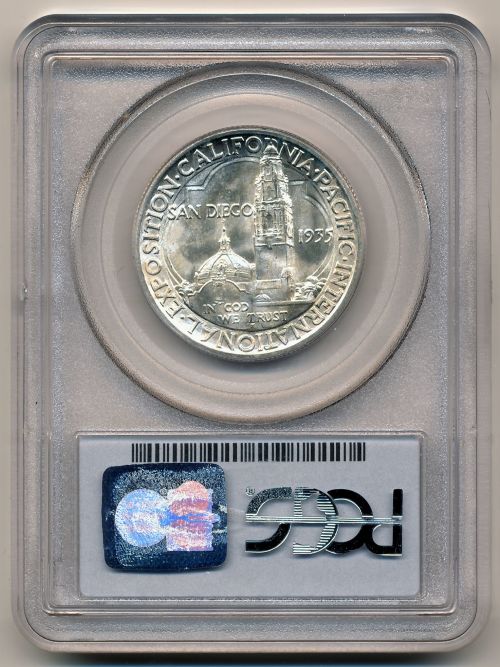Within the classic era of US commemorative coins, there are 11 programs that feature a design struck in multiple years. Not all of these programs were the same, however, when it came to the legal requirements for issuing the coins with more than one date.
Most of the coin programs are linked by the fact that their authorization included a large maximum mintage while simultaneously not including a specification for an end-date for production.
The Act enabling the issue of half dollars in support of the World's Columbian Exposition, for example, authorized 5 million half dollars but did not specify a time frame for minting the coins it authorized. It did not require new legislation that enabled the coin to be issued in 1892 as well as 1893 (the coins were dated with the corresponding year, respectively). The Mint simply operated under its established authority and followed the standard policy/procedure of placing the calendar date/year of the coin's striking on the coins; it didn't need additional authorization from Congress to do so. (There were multiple instances of commemorative coins for which Congress specified a date that needed to appear on a coin regardless of when it was struck; this created several calendar year/stike year mismatches.)
Multiple high-maximum-mintage/no-expiration-date coins followed. The Lewis and Clark Gold $1 coins (maximum mintage of 250,000) of 1904 and 1905, the William McKinley Gold $1 coins of 1916 and 1917 (maximum mintage of 100,000) and the Pilgrim Tercentenary silver half dollars of 1920 and 1921 (maximum mintage of 300,000) were all struck and issued under their original enabling legislation - no amendments/new Acts required for the second year of coinage.
The Oregon Trail Memorial half dollars, issued beginning in 1926 and struck in multiple (but not all) years through 1939, benefited from an Act that authorized 6,000,000 coins without specifying an end-date for production. The Trail Association took full advantage of this and ordered coins from the Mint for more than a decade, with each new issue bearing the year (and mint mark) of striking - no amendments/new Acts needed. (Congress finally put a stop to multi-year programs such as the Oregon Trail in 1939.)
In much the same vein, the Arkansas Statehood Centennial and Texas Independence Centennial programs enjoyed coins with multiple dates (and mint marks) based on their original legislation; each also had the advantage of a large authorized maximum mintage (500,000 for the Arkansas, 1.5 million for the Texas) without any limits placed on when the coins could be ordered from the Mint.
The Booker T. Washington (BTW) program of 1946 through 1951 (5,000,000 maximum mintage) and the George Washington Carver-BTW program of 1951 through 1954 (effectively ~3,400,000 maximum mintage) enjoyed the same large-maximum-mintage/no-mandated-expiration-date-for-order privileges.
Things were different for two of the classic-era program, however, the Daniel Boone Bicentennial program and the California-Pacific International Exposition (aka, San Diego) half dollars. Each of these required the engagement of the US Congress before coins with a date different from their first year of issue could be struck.
The additional legislation required by the Boone half dollars was related to the Boone Commission's request to have a small "1934" - the actual bicentennial anniversary year being commemorated - added to 1935 and beyond issues. I've written about this situation before (see link below), so I won't repeat things here.
That leaves the 1935-36 California-Pacific International Exposition half dollars. The Exposition opened in 1935 and the coins approved to support it were issued and dated the same year. While the Exposition closed for the Winter, its sponsoring Company planned to reopen the Exposition in 1936 for a second season. The Exposition Company desired to reinvigorate sales of its commemorative coin by having a 1936-dated version produced.
As the Mint had already struck and delivered the full authorized mintage (250,000) to the Exposition Company with a date of "1935", it required authorization to accept the return of unsold 1935-dated coins and to re-coin them into 1936-dated pieces. Congress passed such legislation in early 1936 and President Franklin Delano Roosevelt signed the amendment into law on May 6, 1936.
With the new law in place, the Exposition Company returned 180,000 of the unsold 1935-dated coins and awaited its 1936 issue. While the 1935 coins were struck in San Francisco - creating a California connection with the Exposition - the 1936 coins were struck in Denver. Sales of the 1936 coins were disappointing, however, with only approximately 30,000 being purchased. After the Exposition closed, the remaining inventory of half dollars was returned to the Mint to be melted which enabled the Exposition Company to recoup the face value of the coins that it had paid up front.
So, the second date of the "San Diego" half dollar, with its separate legislation, and different date could be considered a distinct type within the classic-era series. I wouldn't categorize it as a different design type, however, as the only change made to the coin's design was the date and mint mark, but it is unique within the series in that it is the only "second-year" coin of the same design that required its own Public Law to be struck. What say you?
1935 California-Pacific International Exposition Half Dollar

For more on the "Small 1934" Boone Bicentennial half dollar, see:
-
The "Small 1934" Boone Bicentennial Half DollarsFor more on the California-Pacific International Exposition half dollar, see:
-
1935 California-Pacific International Exposition-
1935 California-Pacific International Exposition - Original HolderOther of my posts about commemorative coins and medals can be found here:
Commems Collection.























